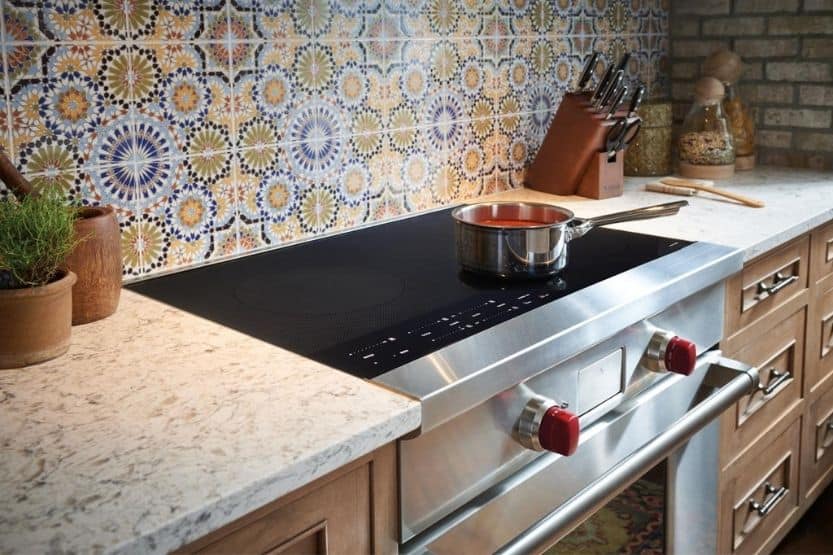Most people often overlook the importance of overall weight when they are thinking of buying a stove. Weight is an important consideration because there are times when you need to move it around. How much does a stove weigh?
On average, a stove that is part of a cooking range weighs about 100 to 250 pounds. Portable stoves weigh about 5 to 20 pounds.
A stove’s weight will depend on the material it is made of, its size, whether it is electric or gas, and the type of cooking range it is a part of.
Commercial stoves used in restaurants and food joints are considerably bigger and heavier than residential stoves. For instance, a 60-inch restaurant stove can be as heavy as 800 pounds. This is more than twice the weight of a residential two-burner 30-inch stove.
Read on to learn more about the weights of stoves, as well as the different types of stoves.
How Much Does a Stove Weigh?

A stove’s weight is determined by its size, material, whether it is electric or gas, and whether it is a part of a cooking range or appliance. On average, a stove can weigh from 100 to 250 pounds. Note that portable stoves weigh much less, only about two to five pounds.
The combination of stove and oven is the most common in United States households. In restaurants, especially the larger ones, the used stoves are bigger and wider than their residential versions. Thus they are also much, much heavier.
Whatever and wherever they are used, the stove weight varies widely because of their range of sizes. The average weight of convection stove/oven combos with sizes ranging from 24 to 30 inches is about 128 pounds.
A restaurant stove with a width of 60 inches can weigh up to 800 pounds. That is more than double the weight of two residential stoves that are 30-inch wide each. Portable ovens, especially those with single burners, are the lightest. They can weigh just about 5 lbs.
Different Types of Stoves and Their Weight
Cooking stoves are available in many styles and sizes. There are residential types and commercial type stoves. Due to the wide variety of sizes, styles, and features, you have to classify stoves based on some of these elements.
This segmentation is done to help consumers easily determine the particular stove that will satisfy their needs. Stoves can be classified according to their type, several burners, surface, and features. We will now discuss these classifications in detail.
According to Type of Heat Source:
1. Gas
There are many advantages to using gas stoves. They can give instant heat and provide fast heating because their flames are stable and powerful. You also have total control in cooking your food by raising or lowering the cooking temperature.
There’s not much worry about burning the food if you use gas cooking stoves. Their average weight ranges from 100 to 250 pounds. The weight of single burner portable stoves starts from 5 pounds.
2. Induction
Use an induction stove if you want a faster cooking time. This is pricier than ordinary gas cooktops, but it offers additional advantages. For example, the heat it produces is transferred directly to the pot or pan.
Unlike gas and electric stoves where the whole stove heats up, only the surface in contact with the pan gets hot in induction stoves. The average weight of induction stoves is between 100 to 250 pounds. A portable single burner induction stove weighs an average of 5 to 8 pounds.
3. Electric
Electric stoves have also been around for quite some time. They are also a great choice for households because of their relatively low price. One of their advantages is that you don’t need to ignite the burner to start cooking.
When you connect it to the source of electricity and switch the burner on, its heating element will start heating the food you are cooking. These stoves are also easy to clean since there is no gas residue left on the top.
The average weight of electric stoves and oven combos is 128 pounds. Portable solo heaters weigh only from 5 to 10 pounds.
4. Oven Ranges
These stovetop/oven combos are the most common type of cooking appliance in most households in the United States. They can be either electric or gas or a combination of both. Most of them have weights that range from 100 to 250 pounds.
The weight of a fundamental cooking range will be around 100 to 130 pounds. It can have three or four burners on the top. This type of burner will not have any smart technology among its features but only the fundamental elements that will allow you to cook, heat, and bake food.
The average standard stove oven combos weigh from 130 to 220 pounds. As oven ranges increase in size and features, they will naturally get bigger, heavier, and pricier.
High-end commercial cooking ranges can be as heavy as 500 pounds. They have more burners at the top and smarter features that add to their weights.
5. Wood Stoves

Another type of cooking stove is a wood stove. A wood stove basically uses wood as its fuel to heat and cook food. Aside from wood, it is also capable of burning wood-derived biomass fuel like bricks made of sawdust.
This kitchen appliance is built of a solid metal enclosure or firebox lined with fire brick and one or two air controllers. Wood stoves also differ according to their builder and model.
How much does a wood stove weigh? The overall mass of an average wood stove can come to about 300 pounds. But that can go higher depending on the size and materials of the stove.
The heavier the wood stove weight, the more mass it will have and the more heat it can produce. In other words, the heavier a wood stove is, the more efficient is its heating and cooking capability.
Weight of Stoves with Different Number of Burners
1. Single Burners
Single burner stoves are the smallest and the lightest of all cooking stoves. They are mostly used by campers and those who love to spend time outdoors. Most of these are gas-powered. Their average weight starts from 5 pounds.
2. Double or 2 Burners
Double burner stoves are usually stand-alone, meaning they exist on their own. They are used mostly by households with limited kitchen space. These stoves are placed on standard height tables to give them stability while they are being used for cooking.
They could be either electric or gas-powered. These stoves are also an additional option for those who have a main cooking range but still need extra cooking stoves. The average weights of double burners range from 7 to 8 pounds.
3. 4 Burners
Cooktops with 4 burners are the most common type of cooking stoves in households in the United States. As such, they are the type of stove/oven combo that has the most options available. The size of this cooking stove provides enough cooking space.
With this type of stove, you will be able to cook different meals and dishes simultaneously. The average weight of 4 burner cooking stoves ranges from 100 to 250 pounds.
4. 5 Burners
Cooktops with 5 burners are ideal for those looking for extra cooking space, but their kitchen area is limited. The extra burner can provide the additional cooking space to heat up or to create an extra meal.
They are typically induction or gas-powered. Electric 5 burners are difficult to find. With the extra burner, their average weight goes up a bit more. It could range from 130 to 300 pounds.
5. 6 Burners
Professional chefs who usually turn out numerous dishes every time they cook need bigger cooktops. The average size cooktop that they use is those with 6 burners. These burners can also be found in households of large families and those who like to entertain in their homes.
Their average size is much bigger than cooktops with four burners. So you will need a lot of kitchen space to fit this kind of cooktop. With more burners on the top, the average weight of 6 burner cooking stoves ranges from 200 to 325 pounds or even more.
Again, how much does a stove weigh? A stove’s weight depends on several factors, including size, material, and type. In general, a stove weighs between 100 to 250 pounds (lbs), while a portal stove weighs between 2 to 5 pounds (lbs).
According to Type of Surface:
1. Gas
Gas burners have the oldest surface form of cooktops. Typically, the burners are set in place by their assembly. And then there is a cover plate that hides all the gas tubes and parts underneath.
Lastly, the metal frame or support holds or carries the weight of the pots and pans while cooking is going on. The weight of stoves with gas burners depends on the number of burners it has on the top.
2. Smooth
Stoves that have smooth tops are also known as “radiant cooktops.” Their great advantage is that you can clean them easily. They work by conducting electricity through the heating elements that are located underneath the smooth ceramic top.

Some of these cooktops have only one single burner. Others have as many as four or five burners. The weight of stoves with gas burners depends on the number of burners it has on the top.
3. Coil
Cooktops powered by electricity have electric coils as their cooking element. They are very durable and are very efficient in providing the temperature for heating and cooking. The coils conduct electricity when the stove is plugged in.
These coils are strong because they are made to support the pan or pan’s weight and its contents while cooking. The number of coils at the top will determine the weight of the electric cooktop.
Aside from these classifications, another aspect is used to specify the type of cooking stoves. This additional element is the distinguishing feature that each stove offers.
These features do not really have much effect on the total weight of the respective cooking stoves. Nevertheless, you still need to know about them since you might find some of these features to be what you need or want from a cooking stove that you are thinking of buying.
Other Features That You Can Use to Classify Stoves
1. Overhead Hood
The steam and smoke released while you are cooking will be drawn to the hood so that they won’t spread around in your kitchen and your house.
2. Automatic Re-Ignition
There are times when the fire from the burner will go out. Then you have to re-ignite the flame to continue cooking. Some cooktops automatically re-ignite the burner, not to have to worry about the flame burning out.
3. Downdraft Extractor
This is an option for those who don’t want overhead hoods on their cooktops. This extractor uses a ventilation system built directly into the stove itself, which draws away smoke and steam while cooking.
4. Digital Touch Controls
It is much easier to push a button instead of turning or pushing a knob to start cooking. This is the convenience offered by cooktops with digital control. All you have to do is press the corresponding temperature or time needed to cook something.
5. LED Display
Convenience is the greatest advantage of a cooktop with a LED display. This type of cooktop will allow you to see the temperature and time while you are busy doing another thing. No more overcooking or burning of food with this type of stove.
6. Safety Features
Fire is a hazard, even if it can be used for heating and cooking. So, if you are concerned about the safety of your family, you can consider stove cooktops that have features that will automatically switch off when cooking is finished or a heater to turn off by itself when needed.
Conclusion: What Is the Average Stove Weight?
On average, stoves that are a part of cooking ranges can weigh between 100 and 250 pounds. A stove’s weight will depend on its size, the material it is made of, whether it is electric or gas, and whether it is a part of a cooking range.
Portable stoves, being stand-alone units, are less heavy. They usually weigh from 5 to 10 pounds, again depending on their make, the number of stoves on top, and their style.
Again, here are the types of stoves according to the heat source:
- Gas
- Induction
- Electric
- Oven Ranges
- Wood Stoves
As we discussed earlier, stoves can also be classified according to the number of burners (e.g., single, double, etc.). Also, they can be classified according to the type of surface:
- Gas
- Smooth
- Coil

![Eye on the Stove - What Is It? [All About the Stove Eye] Eye on the Stove](https://homecarezen.com/wp-content/uploads/2021/11/Eye-on-the-Stove-150x150.jpg)



